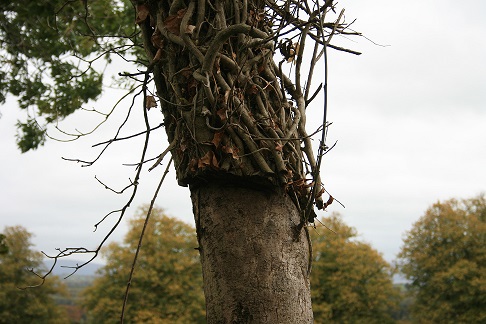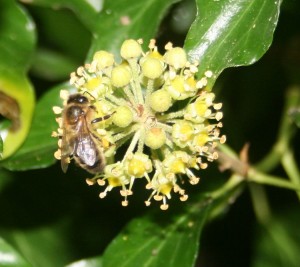Beekeepers know Ivy is a great plant for the bees but is it a tree?
It is when it’s got a great thick woody stem and a big bushy crown with flowers all over it.
Hedera helix
Depending which book you consult, there is one species of Ivy – Hedera helix and up to six possible subspecies in Ireland and Britain. Two subspecies are present in Ireland – H. helix ssp. helix or Common Ivy and H. helix ssp. hibernica, Atlantic Ivy. Both are common throughout Britain and Ireland. However, Atlantic Ivy is more commonly found in Ireland, Wales and the western half of Britain while Common Ivy is more common throughout Britain and in the south west of Ireland.
If you want to find out which sort you’ve got – take a close look at the growing shoot-tips with a powerful magnifying glass – if the little hairs (trichomes) are greyish white with star-shaped tips sticking up at angles then that’s H. helix ssp. helix. If they are brownish and lay flat that’s H. helix ssp. hibernica
They also vary in chromosome numbers which means they do not hybridise which makes things easier!
But is it a tree?
What is a Tree?
Consult Chambers Dictionary(1901) and you will find a tree defined as, “a plant having a single trunk, woody, branched and of a large size.”
Or in Collins Pocket Dictionary (1988) a tree is “a large woody perennial plant with one main trunk which develops many branches.”
If you ask Mr.Google he says it’s “a woody perennial plant, typically having a single stem or trunk growing to a considerable height and bearing lateral branches at some distance from the ground.”
All trees go through at least three different growth phases before they can be considered a tree – after all they don’t spring forth from the seed as a large wood perennial with one main trunk and many branches do they?
No they don’t – there are three phases:
- Young – seedling;
- Juvenile – sapling;
- Mature – tree.
Well it’s the same with ivy.
Ivy Growth Phases
Young
Young ivy plants tend to be creeping ground cover until they find something to climb. They are adapted to survive and grow at very low light levels to be found on a forest floor. They do this by growing very slowly.
If it is a deciduous woodland – winter sunshine filtering down through the bare canopy will allow the ivy to continue to grow even in winter.
Juvenile
The juvenile phase involves growth away from the dark forest floor up towards the sunlight. Upwardly mobile shoots put out little sucker feet as they go and attach themselves to their chosen scaffold whatever that may be. As they continue to grow upwards, they put out side shoots or tendrils which strive to encircle the tree – putting out more of those little sucker feet as they go. Where there are several ivy plants growing up different sides of the same tree, between them they weave a twining network like a string vest as they go.
The juvenile phase can last several years during which time several things can happen at the same time:
- The ivy vest matures. It becomes woody and inflexible and tightens up as the individual stems thicken;
- Where stems cross each other, natural grafting occurs and they fuse together making the network even more inflexible;
- The tree, continues to grow adding growth rings and expanding its girth – or trying to;
- The homely old vest turns into a straitjacket.

Just beneath the bark are little tubules called xylem and phoem. These are like our veins and arteries – but instead of blood, they conduct water and the products of photosynthesis around the tree from source to sink.
So while the tree trunk is trying to expand, the ivy cladding is constricting xylem and phloem. The net effect is the ivy starts to strangle the tree.
The slow strangulation can continue for years and during that time the canopy of the tree starts to thin because the tree can no longer support as many leaves. More sunlight comes through and the ivy enters the mature phase.
Mature
The mature phase is when beekeepers and bees start to take an interest in the ivy.
It has a woody stem and with its head out in the light it grows itself a bushy top with many self-supporting branches – a canopy of its own. It now meets the dictionary definition of a tree and with a wealth of lovely sunlight shining right onto its very own canopy – it turns its thoughts to reproduction and comes into flower.

Bingo!
Bring on the bees.
Friend or Foe
Ivy has great value for wildlife but there is debate about whether ivy kills trees or not and confusion about whether or not it is a parasite.
- Ivy uses trees to climb up but it doesn’t directly parasitise them;
- However, its roots are cheek by jowl in the same soil as the tree roots so they do compete for water and nutrients;
- They also compete for sunlight. While a tree is in good health – its canopy is dense with layers of healthy green leaves. Little sunlight gets through so the tree is able to keep the ivy in its place;
- However, each winter, deciduous trees lose their leaves and winter sunshine comes through;
- The ivy is evergreen and continues to grow – albeit at a slower rate – all the way through the winter and early spring continuing ever onwards and upwards while the tree sleeps.
Creepy ain’t it?
But the ivy sows the seeds of its own destruction because when it completely colonises the crown of a tree and grows its bushy canopy two things happen.
- The stangulation of the tree means the roots are starting to suffer because they need the products of photosynthesis to survive.
- When the autumn and winter gales come, the bushy evergreen canopy of the ivy acts like the sails of galleon and eventually the two trees – the ivy and its partner tree capsize together.
To Cut or not to Cut?
In a woodland setting this is natural cycling and part of the functioning ecosystem. When a tree comes down – there is a clearing. Young trees which have been languishing in the dim light of the forest understory put on great spurts of growth as they race up towards the light. Until new trees have regrown, the ivy is banished once again to the forest floor.
However, on trees like ash and hawthorn which grow in hedgerows and have loose open crowns – ivy is a pest. When allowed to rampage away without check – hedgerows are transformed to tottering lines of derelict trees.
Also in parks and gardens it can destroy beautiful specimen trees. In such situations ivy does need to be checked but in the woods it is best to accept it and enjoy it.
For the birds
Ivy provides much needed shelter, roosting and nesting sites.
It also supports many insect species which are food for birds.
Apparently the ivy berries are as calorific as a Mars bar and great for blackbirds although they tend to leave them till everything else has gone.
For the bees
As we know it is a bee plant of some importance – especially here in Ireland. It is a source of late summer – autumn nectar and pollen which the bees use to build up on and boost winter stores.
For those of us who are organised – it can provide a crop of honey when it flowers early.
Click here for more about Ivy Honey
Click here for details on how to prepare for a crop of Ivy honey.
The pollen loads are yellow and in mellow autumn weather they come thudding in like mad.

For the Humans Beeing
Ivy is said to be poisonous if eaten in quantities so don’t do that.
An ivy bedecked stick on the front of a house was once the signal to all and sundry that there was beer for sale.
Perhaps they chose ivy because it is said to cure hangovers.
For the same reason, Bacchus – god of wine – is crowned with a wreath of ivy leaves on his head thus – the twerp:

Or is it because he’s going to fall over soon as well!
Click here for ivy honey cold cure recipe
Click here for Bee Trees – Hawthorn
Click here for Bee Trees – Hazel
Click here for Bee Trees – Horse Chestnut
Click here for Bee Trees – Sycamore
Click here for Bee Trees – Willow
Click here for Bee Trees – Lime
Click here for Bee Trees – Poplar
Click here for Melampsora Rust Spores
Sources
Biological Records Centre http://www.brc.ac.uk/
Clapham, A.R., Tutin, T.G. and Warburg, E.F. Excursion Flora of the British Isles. Third Edition. Cambridge University Press. 1995
Fitter. R., Fitter. A. and Blamey, M. The Wildflowers of Britain and Northern Europe. Collins. London. 1985
Keble Martin, W. The New Concise British Flora. Book Club Associates, London. 1978
Metcalfe, D.J. Hedera helix L. Journal of Ecology Volume 93, Issue 3, pages 632–648, June 2005
Online Atlas of the British and Irish Flora
Copyright © Beespoke.info, 2015. All Rights Reserved.

Just discovered this absolutely wonderful site.
Ivy honey is a passion for me. After winter feeding promptly without supers I reinstate a super for the ivy flow, removing it at the end of October.
With its very hard rapid granulation I fill sweet moulds with it or a flat try in order to cut into fudge like chunks which can be
additionally decorated.
Secret out, niche market for someone, let me know.
Now that is very interesting!
Any idea how it would behave under a nice coating of dark chocolate?
And by the way – how do you extract your ivy honey?